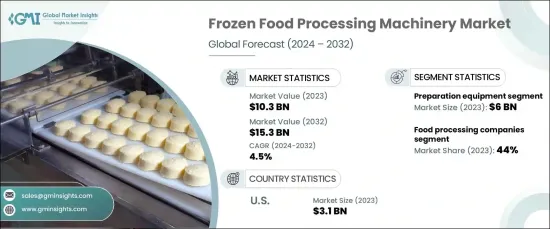
세계의 냉동식품 가공기계 시장은 2023년 103억 달러에 달하며, 2024-2032년에 4.5%의 CAGR로 견고하게 성장할 것으로 예측됩니다. 이러한 성장을 주도하는 것은 자동화, 인공지능(AI), 머신러닝의 발전으로, 효율성을 높이고 비용을 절감하여 식품 가공 기계에 혁명을 일으키고 있습니다. 급속냉동, 극저온법 등 냉동기술의 혁신은 식감과 영양소 보존을 통해 식품의 품질을 유지하는 데 매우 중요한 역할을 하고 있습니다. 이는 냉동 과일, 채소, 해산물에 대한 수요 증가에 대응하는 데 매우 중요합니다.

퀵서비스 레스토랑(QSR)의 확대와 온라인 음식 배달 부문의 호황은 냉동식품 산업의 성장에 박차를 가하고 있습니다. 이러한 부문은 냉동 제품에 크게 의존하고 있으며, 높은 수요를 충족시키기 위해 첨단 가공 기계의 필요성이 증가하고 있습니다. 또한 전 세계에서 슈퍼마켓과 대형마트의 확산은 소매 부문의 냉동식품에 대한 의존도를 가속화하고 있습니다. 소매업체들은 진화하는 소비자 기호에 대응하고 제품 품질을 보장하기 위해 첨단 장비에 대한 투자를 점점 더 많이 늘리고 있습니다.
| 시장 범위 | |
|---|---|
| 시작연도 | 2023년 |
| 예측연도 | 2024-2032년 |
| 시작 금액 | 103억 달러 |
| 예상 금액 | 153억 달러 |
| CAGR | 4.5% |
이러한 발전에도 불구하고 특히 신흥 시장의 소규모 제조업체들은 상당한 장애물에 직면해 있습니다. 현대식 장비에 대한 높은 초기 비용과 예산의 제약이 결합되어 최첨단 기계에 대한 접근이 제한되는 경우가 많습니다. 공급망의 혼란은 중요한 부품과 포장재 수급을 더욱 복잡하게 만들고, 생산 지연으로 이어집니다. 이러한 문제들은 역동적인 시장에서 경쟁하려는 중소기업에게 큰 장벽이 될 수 있습니다.
기계 유형별로 보면 2023년 준비 장비는 60억 달러의 매출을 창출하며 시장을 장악했습니다. 이 분야는 2024-2032년 약 4.7%의 연평균 복합 성장률(CAGR)로 꾸준히 성장할 것으로 예상됩니다. 조리 장비는 슬라이스, 절단, 혼합 및 분쇄 툴로 구성되며 냉동식품 제조에 중요한 역할을 합니다. 이러한 장비는 제품의 품질을 유지하고 냉동 공정을 최적화하는 데 필수적인 크기와 모양의 일관성을 보장합니다.
2023년 시장 점유율은 식품 가공업체가 약 44%를 차지했으며, 이러한 추세는 2032년까지 비슷한 성장 궤도를 그릴 것으로 예상됩니다. 유통기한이 연장된 편의식품에 대한 수요 증가는 이러한 기업의 생산량 증가로 이어지고 있습니다. 그 결과, 고성능 기계에 대한 투자가 급증하여 기업은 높아진 소비자의 기대에 부응할 수 있게 되었습니다.
미국은 여전히 냉동식품 가공 기계 시장을 지배하는 국가로, 2023년 시장 규모는 31억 달러였습니다. 이 시장은 냉동 기술의 끊임없는 혁신으로 인해 2024-2032년 연평균 4.9%의 성장률을 보일 것으로 예상됩니다. 이러한 발전은 생산 효율을 높이고 제품 품질을 향상시키며 미국 식품 가공 산업 증가하는 수요를 지원하고 있습니다.
The Global Frozen Food Processing Machinery Market was valued at USD 10.3 billion in 2023 and is projected to grow at a robust CAGR of 4.5% from 2024 to 2032. Driving this growth are advancements in automation, artificial intelligence (AI), and machine learning, which are revolutionizing food processing machinery by enhancing efficiency and cutting costs. Innovations in freezing technologies, such as quick freezing and cryogenic methods, are playing a pivotal role in maintaining food quality by preserving texture and nutrients. This is crucial for meeting the rising demand for frozen fruits, vegetables, and seafood.

The expansion of quick-service restaurants (QSRs) and the booming online food delivery sector are fueling the frozen food industry's growth. These sectors rely heavily on frozen products, spurring the need for advanced processing machinery to meet high demand. Additionally, the global proliferation of supermarkets and hypermarkets is accelerating the retail sector's reliance on frozen foods. Retailers are increasingly investing in state-of-the-art equipment to cater to evolving consumer preferences and ensure product quality.
| Market Scope | |
|---|---|
| Start Year | 2023 |
| Forecast Year | 2024-2032 |
| Start Value | $10.3 Billion |
| Forecast Value | $15.3 Billion |
| CAGR | 4.5% |
Despite significant advancements, smaller manufacturers, especially in emerging markets, face notable obstacles. High upfront costs for modern equipment, coupled with budget constraints, often limit their access to cutting-edge machinery. Supply chain disruptions further complicate the availability of critical components and packaging materials, leading to production delays. These challenges pose substantial barriers for smaller players striving to compete in this dynamic market.
In terms of machinery type, preparation equipment dominated the market in 2023, generating USD 6 billion in revenue. This segment is anticipated to grow at a steady CAGR of approximately 4.7% from 2024 to 2032. Preparation equipment-comprising tools for slicing, cutting, blending, and grinding-plays a critical role in frozen food production. These machines ensure consistency in size and shape, which is essential for maintaining product quality and optimizing freezing processes.
Food processing companies accounted for approximately 44% of the market share in 2023, and this trend is expected to continue with a similar growth trajectory through 2032. The rising demand for convenience foods with extended shelf lives has led to increased production among these companies. Consequently, investments in high-performance machinery have surged, enabling companies to meet growing consumer expectations.
The United States remains a dominant player in the frozen food processing machinery market, valued at USD 3.1 billion in 2023. The market is forecasted to expand at a CAGR of 4.9% from 2024 to 2032, driven by continuous innovation in freezing technologies. These advancements are enhancing production efficiency, improving product quality, and supporting the growing needs of the US food processing industry.